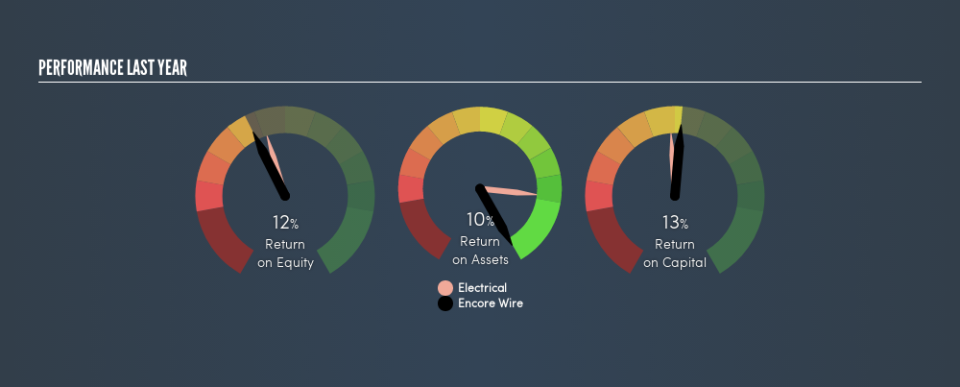Are Encore Wire Corporation’s (NASDAQ:WIRE) Returns On Investment Worth Your While?

Want to participate in a short research study? Help shape the future of investing tools and receive a $20 prize!
Today we’ll look at Encore Wire Corporation (NASDAQ:WIRE) and reflect on its potential as an investment. In particular, we’ll consider its Return On Capital Employed (ROCE), as that can give us insight into how profitably the company is able to employ capital in its business.
First, we’ll go over how we calculate ROCE. Next, we’ll compare it to others in its industry. Then we’ll determine how its current liabilities are affecting its ROCE.
Return On Capital Employed (ROCE): What is it?
ROCE measures the amount of pre-tax profits a company can generate from the capital employed in its business. Generally speaking a higher ROCE is better. Ultimately, it is a useful but imperfect metric. Renowned investment researcher Michael Mauboussin has suggested that a high ROCE can indicate that ‘one dollar invested in the company generates value of more than one dollar’.
How Do You Calculate Return On Capital Employed?
The formula for calculating the return on capital employed is:
Return on Capital Employed = Earnings Before Interest and Tax (EBIT) ÷ (Total Assets – Current Liabilities)
Or for Encore Wire:
0.13 = US$79m ÷ (US$799m – US$82m) (Based on the trailing twelve months to September 2018.)
Therefore, Encore Wire has an ROCE of 13%.
See our latest analysis for Encore Wire
Is Encore Wire’s ROCE Good?
ROCE can be useful when making comparisons, such as between similar companies. We can see Encore Wire’s ROCE is around the 11% average reported by the Electrical industry. Regardless of where Encore Wire sits next to its industry, its ROCE in absolute terms appears satisfactory, and this company could be worth a closer look.
When considering this metric, keep in mind that it is backwards looking, and not necessarily predictive. ROCE can be deceptive for cyclical businesses, as returns can look incredible in boom times, and terribly low in downturns. ROCE is, after all, simply a snap shot of a single year. Future performance is what matters, and you can see analyst predictions in our free report on analyst forecasts for the company.
What Are Current Liabilities, And How Do They Affect Encore Wire’s ROCE?
Liabilities, such as supplier bills and bank overdrafts, are referred to as current liabilities if they need to be paid within 12 months. The ROCE equation subtracts current liabilities from capital employed, so a company with a lot of current liabilities appears to have less capital employed, and a higher ROCE than otherwise. To check the impact of this, we calculate if a company has high current liabilities relative to its total assets.
Encore Wire has total liabilities of US$82m and total assets of US$799m. Therefore its current liabilities are equivalent to approximately 10% of its total assets. Current liabilities are minimal, limiting the impact on ROCE.
The Bottom Line On Encore Wire’s ROCE
This is good to see, and with a sound ROCE, Encore Wire could be worth a closer look. But note: Encore Wire may not be the best stock to buy. So take a peek at this free list of interesting companies with strong recent earnings growth (and a P/E ratio below 20).
For those who like to find winning investments this free list of growing companies with recent insider purchasing, could be just the ticket.
We aim to bring you long-term focused research analysis driven by fundamental data. Note that our analysis may not factor in the latest price-sensitive company announcements or qualitative material.
If you spot an error that warrants correction, please contact the editor at editorial-team@simplywallst.com. This article by Simply Wall St is general in nature. It does not constitute a recommendation to buy or sell any stock, and does not take account of your objectives, or your financial situation. Simply Wall St has no position in the stocks mentioned. On rare occasion, data errors may occur. Thank you for reading.

